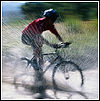 Weekly Maintenace
Weekly Maintenace
 he best way to keep a bike in tip-top shape is to apply
weekly maintenace. During much of the
year you probably ride several times a week. To keep your bike working efficiently and
reliably, devote some time each week to cleaning, lubricating, and adjusting. This general
maintenance will also help you find a problem before it results in a breakdown. If a
repair is necessary, consult the appropriate subject (right bar) for instructions. he best way to keep a bike in tip-top shape is to apply
weekly maintenace. During much of the
year you probably ride several times a week. To keep your bike working efficiently and
reliably, devote some time each week to cleaning, lubricating, and adjusting. This general
maintenance will also help you find a problem before it results in a breakdown. If a
repair is necessary, consult the appropriate subject (right bar) for instructions.
Clean and
Inspect
Put your bike in a work stand or against a support.
Unless the frame is filthy, use a soft rag to polish it with a cleaner/wax such as Bike
Elixir. Otherwise, wash it with a brush and mild detergent, then rinse and dry it well.
As you clean, inspect for frame damage. Look for
bulges and cracks in the metal, especially at tube intersections. If you find any, have
the problem evaluated by a pro mechanic. Use touch up paint on scratches or chips that
expose bare metal.
Next, dip a corner of your rag in a solvent such as
kerosene, or spray it with a lubricant such as WD-40 or Tri Flow. Wipe each component
clean, inspecting for cracks, loose bolts, and so on as you work. Save the drivetrain
(crankset and derailleurs) for last because these parts are usually the dirtiest.
Do not clean rims with solvent, which can
leave an oily film that renders the brakes useless. Instead, wipe the rims with a clean,
dry rag. Inspect each spoke hole for cracks and for ferrules pulling through. Look for
dents or gouges in the sidewalls. Replace a damaged rim immediately.
Wipe the spokes and squeeze each pair to find any
that are loose or broken. Spin each wheel and watch the rim where it passes the brake
pads. If you see large wobbles or hops, true the wheel before riding again or the rim
could become damaged beyond repair. Check for loose hub bearings by wiggling the rim side
to side. There should be no play.
Examine each tire's tread for embedded glass or
other debris. Potential puncture producers can often be removed before they work through
the tire casing. Also check the tread and sidewalls for cuts and bulges. Damaged tires
must be replaced immediately. Their failure is inevitable. If you have tubular tires, try
to push them off the rim with your thumbs. If they budge, reglue them.
Squeeze and
Wiggle
Firmly squeeze each brake lever. Anything pop
loose? Make sure each pad contacts the rim properly and recedes about 2 mm when the lever
is released. Make fine cable adjustments with the barrels on the calipers or brake levers.
Check the headset adjustment by squeezing the front
brake lever and rocking the bike back and forth. Clunking indicates looseness. If it
sounds okay, lift the front wheel slightly and nudge the handlebar. Does the headset seem
to catch when the wheel points straight ahead? A worn or tight headset reduces steering
control, so have it repaired soon. Place an ear against the tip of the saddle and turn the
handlebar. Rumbling means the bearings are dry or dirty.
Grasp a crankarm and wiggle it side to side. There
shouldn't be play. A loose crankset will impair shifting and wear out prematurely. Tap
each chainring bolt. If one is loose, you'll hear it. Once a month, remove the pedals,
unship the chain, and check the condition of the bottom bracket bearings by putting your
ear to the saddle as you turn the crank.
While the pedals are off, turn their axles and feel
for roughness. Inspect the toe clips for cracks and loose bolts. Check the straps for wear
and damaged buckles.
Grasp the saddle by the tip and tail, and shake it
in all directions. Do the same with the handlebar. Tighten anything that slips. Check the
nuts and bolts on accessories such as bottle cages and racks. Make sure there's a fresh
spare tube or tire in your tool kit, and be certain your frame pump works.
Lube and
Inflate
The two surest (and simplest) ways to help your
bike work well are to maintain proper tire pressure and frequently lubricate your chain. A
lubed chain shifts better, runs quieter, and lasts longer. Full tires roll efficiently and
protect your rims from damage.
Chain maintenance is a simple matter of wiping the
links clean with a rag, then applying a lubricant. This can be done with the chain on the
bike. If the chain is filled with sludge, however, you'll need to remove it and use a
solvent.
Recommended tire pressure is usually printed on the
sidewall. In general, high pressure clinchers and training tubulars require about 110 psi.
If you're in doubt, call a bike shop. Most floor pumps with a built in gauge are
reasonably accurate. The pumps at gas stations are risky to use because they quickly
deliver a large volume of air, which can blow out a bike tire.
Once you've established your weekly maintenance
routine, the work will take only about 20 minutes. This small amount of time pays off big
in confidence, safety, and smooth, efficient riding. |
